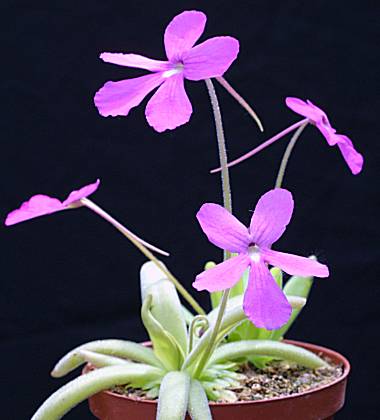
Jan Flísek & Kamil Pásek
Carnivorous Plant Newsletter, Volume 29, No. 4, December 2000, pp. 118-119
Keywords: cultivar: Pinguicula ‘Aphrodite’.
Submitted for registration on 23 February 2000

In July 1998 Mr. Jan Flísek made a bilateral cross-pollination of the Mexican plants Pinguicula agnata and P. moctezumae. Four weeks later, ripe seeds were harvested from P. agnata, whereas the pollinated P. moctezumae did not produce seed. Mr. Kamil Pásek sowed most of the seeds (from two developed capsules) under sterile conditions in vitro at the end of August 1998. The rest of the seed was sown conventionally. Germination of the seeds was in both cases almost 100% within 3-4 weeks.
Owing to rapid in vitro growth over a period of 18 months, we were able to observe the nature of a large number of individual plants. We did not find any significant variability among the individual germinated plants; hence we regard all the individuals resulting from this crossbreeding as identical. The plants are eminently interesting, unique and deserve a special epithet. We have sufficient information to describe the new cultivar we name Pinguicula ‘Aphrodite’.
The cultivar Pinguicula ‘Aphrodite’ is characterized by its very long, narrow leaves with rounded tips which terminate in a point. The summer rosette consists of up to 15 leaves which are up to 12 cm long and 2 cm wide; the leaf-edges roll downwards. The erect leaves display a characteristic, descending-arch along their lengths. Under intense summer sunlight, the leaf-edges of leaves can be reddish, whereas the leaf midribs remain green along their entire length. During the winter, the rosette size decreases, whilst the number of leaves increases to as many as 25. The leaves of the winter rosette are up to 5-6 cm long and 1.3 cm broad; mostly they are flat and light green.
The plants bloom all year round, indeed during winter the plants can have the most flowers open at the same time. The color and size of the flowers changes as the flowers age. Freshly open flowers are relatively small and are generally dark-violet. As the flowers age they enlarge and fade to pink. When viewed from the proper angle the petals reflect light to give a shiny appearance. The posterior side of the flower is significantly lighter in color. Gentle, faint veining is apparent over the entire surface of the five (very exceptionally six) petals; this venation is more distinct towards the flower center. The entrance to the corolla tube and the tube itself is bright yellow, and minutely hairy. Mature flowers can reach 4 cm in a diameter and this fact ranks them among the true giants of the Pinguicula! The spur of the flower is narrow, slightly bowed and may be up to 1.5 cm long. Flowering time is about four weeks depending on the growing condition. Flower stalks can reach 15 cm in length (exceptionally 22 cm), the upper part of the stalk (about 1-2 cm) can be brownish-red, and the lower part is green and covered with tentacles. The sepals are a rich green color. We have tried to crossbreed different individuals of Pinguicula ‘Aphrodite’, or Pinguicula ‘Aphrodite’ plants using other species and hybrids as pollen donors (namely, P. agnata, P. emarginata, P. esseriana, P. ‘Gina’, P. gracilis, P. ‘Sethos’, P. moctezumae, P. rotundiflora, or P. sharpii). However the plants have never produced any seeds so it seems Pinguicula ‘Aphrodite’ is sterile. We have used Pinguicula ‘Aphrodite’ as a pollen donor in hybrid crosses, and have produced seed several times. At present we are unsure about the quality of these seeds.
This cultivar is very vigorous and easy to grow using the standard methods for cultivating Mexican Pinguicula. Moist planting medium (but not waterlogged), even during the winter season, leads to better growth of the plant. We can recommend only one successful method to propagate this cultivar without any problems--using leaf cuttings.
This cultivar is named after Aphrodite, the Greek goddess of love and beauty. Beautiful Aphrodite was much in demand and liked by many of the gods. We hope that Pinguicula ‘Aphrodite’ will find a place in many collections of carnivorous plants as an adornment at least, just as Aphrodite was the gem of the Greek goddesses on Mount Olympus.
In addition to the above data we include a short description of the parental plants used in making Pinguicula ‘Aphrodite’.
P. agnata (section Agnata; maternal plant): the diameter of the rosette is 25 cm, leaf 4-5 cm wide, the edge of the leaf is reddish in summer. The flower is white, 2.5 cm in diameter, with blue edges and a minute yellow central spot, fragrant. Origin unknown (plant was obtained at the floristic exposition, 1990).
P. moctezumae (section Orcheosanthus, paternal plant), the diameter of the rosette 20 cm, leaves green and narrow (7 mm). The flower is pink, 3 cm in diameter, with a well-marked white central spot. Origin Oliver Gluch, Germany (1998).
We wish to extend great thanks, especially to Mr. Loyd Wix (England), Oliver Gluch (Germany), Barry Meyers-Rice (USA), Jan Schlauer (Germany) and Michiaki Mabuchi (Japan) for their critical comments, and also we thank Mr. Marek Svítek for his help in making the English translation of this text. The plants Pinguicula ‘Aphrodite’ have been sent as a present to the above-mentioned friends and other ones some time ago. The plants can be obtained also from the addresses of both authors without any problems.
"Used with joint permission of the International Carnivorous Plant Society"
www.carnivorousplants.org
Copyright (c) Kamil Pásek & Jan Físek, 2000